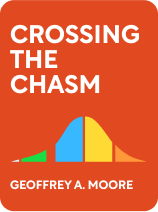

This article is an excerpt from the Shortform book guide to "Crossing the Chasm" by Geoffrey Moore. Shortform has the world's best summaries and analyses of books you should be reading.
Like this article? Sign up for a free trial here .
What does Moore mean by “crossing the chasm”? How does remaining in the chasm between the early market and the mainstream market sabotage your business?
According to Moore, in order to succeed in the early market, the company must “cross the chasm.” At a high level, crossing the chasm means becoming the market leader in a very specific niche market, and then expanding into other niches until you dominate the whole market.
In this article, we’ll present an overview of Moore’s advice on how to cross the chasm.
Crossing the Chasm: High-Level Strategy
At a high level, Moore’s strategy for crossing the chasm consists of focusing your efforts on becoming the market leader in a very specific niche market, then expanding into other niches until you dominate the market.
According to Moore, the reason this works is that it has an amplifying effect on marketing. The members of the early majority communicate closely within their own industry, but not outside of it. Moore also asserts that all marketing is ultimately dependent on word-of-mouth. Word of mouth spreads quickly through a small niche market: If just a few customers are impressed with your product, everyone will hear about it, whereas in a large market, their voices would be lost in the crowd.
(Shortform note: Regis McKenna, a pioneering marketer who made his name publicizing tech companies and their products (including Apple, America Online, and Compaq), echoes Moore’s assertion that word-of-mouth is the most effective method of marketing. His premise is that word-of-mouth is an experience that turns raw information into effective communication. The marketing message is inherently tailored to the individual, and feedback is instant, increasing its impact and reducing misunderstandings. He goes on to cite the “90-10 rule,” namely that 90% of the population’s decisions are determined mostly by the influence of the other 10%.)
Moore breaks down his strategy on how to cross the chasm into four steps:
- choose your niche
- assemble your whole product
- position your product as the market leader in your niche
- setup distribution
Step 1. Choose Your Niche
Moore notes that when you first cross the chasm, you don’t have enough existing market data to choose your niche based on rational analysis, so you have to choose it based on intuition. He further observes that it’s easier to intuitively predict the behavior of a person than an abstract entity like “the market for electric cars.” Thus, he recommends creating hypothetical customer profiles and purchasing scenarios that show how each hypothetical customer would benefit from your product. Then you can select your niche by choosing the most promising of these archetypal customers.
(Shortform note: Moore is not the only one to advocate intuitive decision making in situations like this. Malcolm Gladwell encourages you to harness the power of “unconscious thinking,” which is his term for the mental processes that make up intuition. He contrasts “unconscious thinking” with “conscious thinking,” or analytical decision making. By comparison, unconscious thinking is faster, less susceptible to stress, and less sensitive to the amount of available data.)
Step 2. Assemble Your Whole Product
Moore refers to the complete solution that your customer wants as the “whole product,” in contrast to your core product, which only provides a central piece of the solution. For example, if you had invented the smartphone, the phone itself would be your core product, while the phone’s operating system, a data service plan, and electricity to charge the phone are all components of the “whole product.”
(Shortform note: The “whole product” concept is also called the “total product.” Most sources credit Theodore Levitt for developing the concept in his book The Marketing Imagination. However, in that book, Levitt himself attributes the concept to Harvard Business School professor Raymond Corey.)
Moore observes that to build a good reputation for your product, you need to make sure your customer can readily use it within a complete, working solution. Thus, you need to identify every component of the whole product and make sure your customer can easily access it. There are three possibilities for any given component:
- You can design your product to use elements that are already readily available, like 120 V AC electricity.
- If a component is difficult to find or install, you can bundle it with your product, like a phone that comes with the operating system already installed.
- If it’s not something readily available but also not something you want to provide yourself, you can partner with another company to deliver that part of the whole solution. For example, maybe you want to deploy a hydrogen-powered car, and you coordinate with another company that can supply hydrogen fuel and set up fueling stations for your customers.
(Shortform note: After briefly mentioning all three of these options, Moore devotes significant space to discussing corporate alliances. From this we infer that he considers partnerships a particularly important method supplying the whole product. Meanwhile, McKenna stresses the importance of relationships with other companies not only for supplying the whole product, but also for establishing your company’s reputation by association.)
Step 3. Position Your Product as the Market Leader in Your Niche
Moore uses the word “positioning” to describe how potential customers view a product or company and where they place it on the market landscape in relation to competing products or companies. Clearly identifying your competitors and defining your positioning claim helps to focus your marketing efforts so that customers are more likely to position your product where you want them to.
(Shortform note: In Pitch Anything, Oren Klaff recommends introducing your product with a standardized statement to the effect of “For [you target customers] who are unsatisfied with [competitor], [your product name] provides [the customer’s compelling reason to buy]. Unlike [competitor], [your product name] provides [these key features].” Moore’s theory tracks closely to this template, providing a straightforward and clear way to communicate the most important aspects of your product.)
Moore says that, to early-majority customers, the most convincing evidence of market leadership is market share. However, since you don’t have the largest market share yet, the evidence that you soon will is your commitment to delivering the whole product through alliances with other companies.
(Shortform note: Regis McKenna asserts that you can enhance your company’s reputation by associating with other companies with strong reputations. He argues that the strongest evidence for a positioning claim of market leadership is financial success (corroborating Moore’s assertion about market share), but that when you don’t yet have a proven track record of financial success, the reputation of your financial backers can be an important source of credibility.)
Step 4. Setup Distribution
The final step in Moore’s strategy is to set up distribution so that your target customer can actually buy your product. For the purpose of distribution, he categorizes target customers according to their job titles, and advises that these different customers are more easily reached by different sales channels:
- According to Moore, Engineers are best reached by a two-phase approach: First you publish your product specifications online. Then you send sales personnel to meet with them and conduct demonstrations or facilitate testing once they express interest. This works because engineers don’t respond well to promotional marketing and typically don’t have corporate purchasing authority, but can put you in touch with their purchasing department when you demonstrate your product.
- Moore recommends reaching out to Enterprise Executives by sending your senior staff to leadership conferences where they can connect with them and develop a consultant-like relationship. He calls this “relationship marketing.”
- Moore advises cultivating relationships with Department Managers through an online system that provides basic information about your product, and then connects them with a human sales representative who is also online. Managing customer relationships digitally is more efficient, which is important because department managers typically place smaller orders than enterprise executives.
- If your target customer is a Small-Business Owner-Operator, Moore recommends distributing your product through a value-added reseller (VAR). VAR’s can provide local service and support, as well as helping the customer set up the product, and educating them on how to use it, all of which small business owners tend to find particularly helpful.
- For selling to End Users, Moore recommends fully-automated online self-service, with FAQ and community help forums to streamline support. This is necessary because end users typically make relatively small purchases, and so you can’t afford to spend time dealing personally with each customer.

———End of Preview———
Like what you just read? Read the rest of the world's best book summary and analysis of Geoffrey Moore's "Crossing the Chasm" at Shortform .
Here's what you'll find in our full Crossing the Chasm summary :
- An explanation of the chasm phenomenon that many new high-tech products face
- How to pilot a product across this chasm to mainstream success
- The problems with the Technology Adoption Life Cycle (TALC) model






